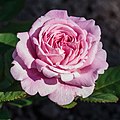Rose hip seed oil
This article needs additional citations for verification. (August 2013) |
Rose hip seed oil is a pressed seed oil, extracted from the seeds of a wild rose bush (Rosa moschata or Rosa rubiginosa) in the southern Andes. Rosehip seed oil can also be extracted from Rosa canina, which grows in many regions of the world including South Africa and Europe.
Nutrition
The oil contains provitamin A (mostly beta-Carotene). It has been wrongly said to contain retinol (vitamin A) which is a vitamin solely made by animals from provitamin A. It does however contain levels (up to .357 ml/L) of tretinoin or all-trans retinoic acid, a vitamin A acid that retinol converts to.[1]
Similarly, while the fruit is rich in vitamin C, the oil does not contain any, as it is a water-soluble vitamin.
Rose hip seed oil is high in the essential fatty acids: linoleic acid or omega-6, and linolenic acid or omega-3.
Uses
This article needs more reliable medical references for verification or relies too heavily on primary sources. (January 2016) |  |
It is commonly used in skin care products. It is commonly used for a variety of skin conditions, including dermatitis, and eczema, for mature and sun burnt skin as well as brittle nails and wrinkles. Rose hip oil is also frequently used to heal scarring and diminish photo-aging.[2]
It quickly absorbs into the skin replenishing moisture and creates a protective barrier on the skin to help prevent dehydration. [3]
References
- ^ J. Concha, C. Soto, R. Chamy, M. E. Zúñiga (2006). "Effect of rosehip extraction process on oil and defatted meal physicochemical properties". Journal of the American Oil Chemists' Society. 83 (9): 771–775. doi:10.1007/s11746-006-5013-2.
{{cite journal}}: CS1 maint: multiple names: authors list (link) - ^ "A Present from Chile: Rosehip Seed Oil". Oily Oily. Retrieved 13 August 2013.
- ^ "Rose Hip Oil Benefits". JenRuhman. Retrieved 10 September 2014.
Further reading
- Andersson, Staffan (2009). Carotenoids, tocochromanols and chlorophylls in sea buckthorn berries (Hippophae rhamnoides) and Rose Hips (Rosa sp.). Diss. (sammanfattning/summary) Alnarp : Sveriges lantbruksuniv., Acta Universitatis agriculturae Sueciae, 1652-6880 ; 2009:58. ISBN 978-91-576-7405-0
- Musa Özcan. Journal of Medicinal Food. September 2002, 5(3): 137-140. doi:10.1089/10966200260398161.

